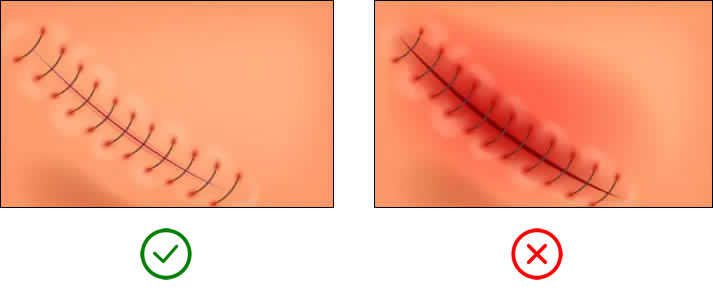Caring for your child’s wound is important for healing, avoiding infection and reducing scarring.
Painful or itchy wound
Your child should feel less pain each day. As the wound heals, it’s normal for it to be itchy.
If your child has pain, you can give them paracetamol or ibuprofen. If the pain continues or you have concerns, see your GP or bring your child to your nearest emergency department.
If the wound is itchy tell your child to pat the area instead of scratching or rubbing.
To help stop infection, check your child’s fingernails each day and trim and clean them.
Watch for infection
It’s normal for your child’s wound to appear slightly red or raised. The edges of the wound should come together neatly and there should be no open areas.
Example of a normal (left) and an infected wound (right)

Signs of infection
Signs of infection may include:
- redness, especially in an uneven pattern around the wound
- increased ooze, either bleeding or yellow or green discharge
- increased pain or tenderness in the wound or surrounding skin
- swelling or a firmness around the wound
- a temperature
- the wound felling hotter than the surrounding skin
- an unpleasant odour or smell.
Keep the wound dry
It’s important to keep the wound dressing dry. Even plastic dressings or those that look waterproof, shouldn’t be put in water.
Don’t give your child a bath until your GP tells you too. Give them a sponge bath or shower instead.
Changing or removing the dressing
You can remove most dressings one to two weeks after surgery, unless you're told not to. However, if the dressing gets wet, you’ll need to change it.
Before you change or remove the dressing make sure to wash your hands. You should also do this after you’ve touched the wound or put a new dressing on.
If the wound appears well healed, you don’t need to put a new dressing on.
Activities to avoid
While the wound is healing, you may need to postpone or limit some activities or sports, this is because knocks and bumps may damage it.
Your child should also avoid swimming and going near sand and dirt.
It’s also important to avoid activities that will make your child overheated or sweaty.
When to seek help
See your GP if:
- you have concerns about your child’s wound
- the wound has areas that are open
- the wound becomes swollen or red around the edges
- redness around the wound spreads to the surrounding skin
- more than half of the dressing is wet with blood or ooze
- your child develops a fever
- the wound smells or there is a yellow or green discharge
- you think that it may be healing too slowly.
In an emergency, call Triple Zero (000) and ask for an ambulance.
If you're not sure whether to go to an emergency department, call 13 HEALTH (13 43 25 84) and speak to a registered nurse.
Developed by the Division of Surgery and Perioperative Services. We acknowledge the input of consumers and carers.
Resource ID: FS159. Reviewed: November 2022.
Disclaimer: This information has been produced by healthcare professionals as a guideline only and is intended to support, not replace, discussion with your child’s doctor or healthcare professionals. Information is updated regularly, so please check you are referring to the most recent version. Seek medical advice, as appropriate, for concerns regarding your child’s health.
Last updated: October 2023